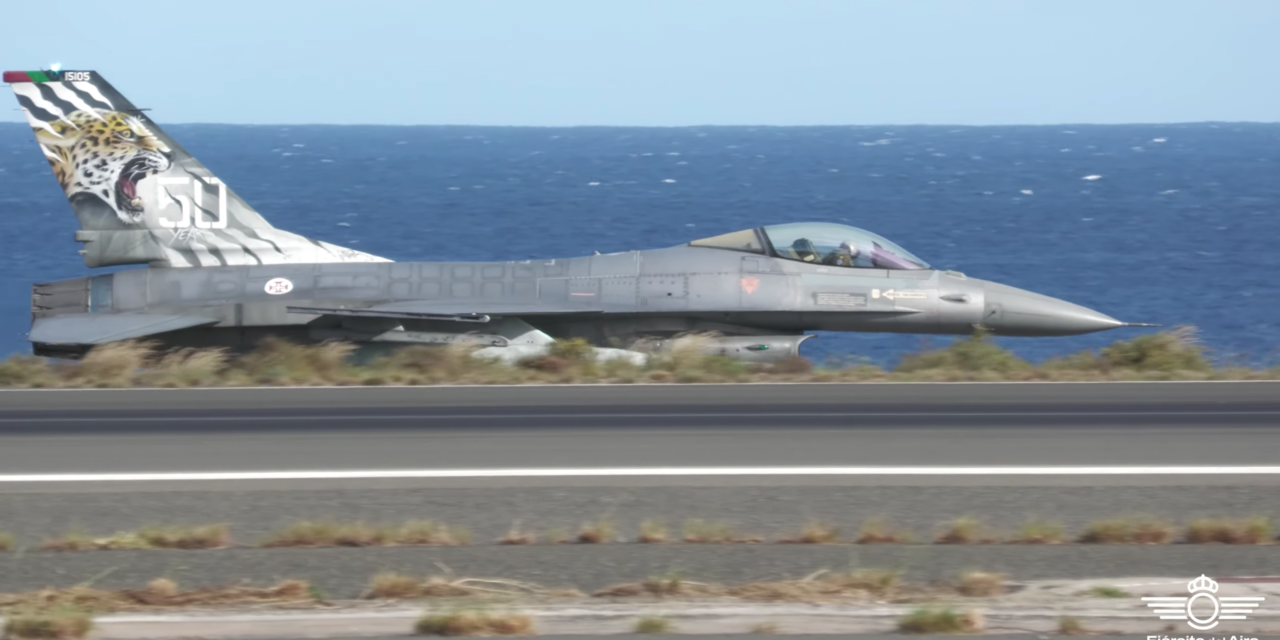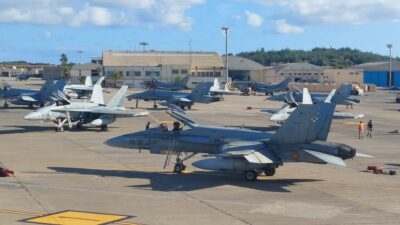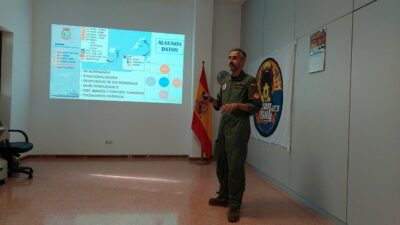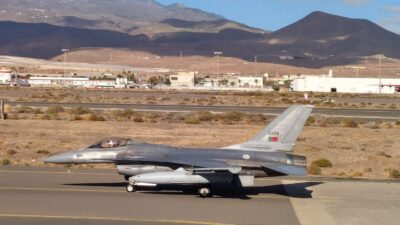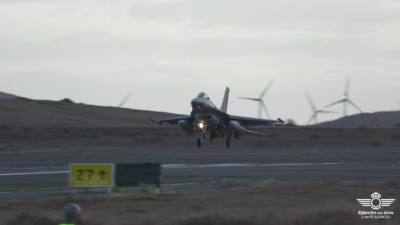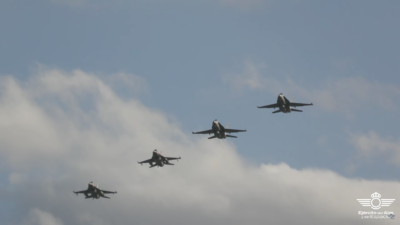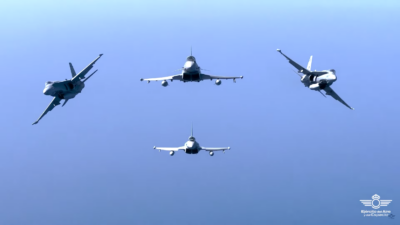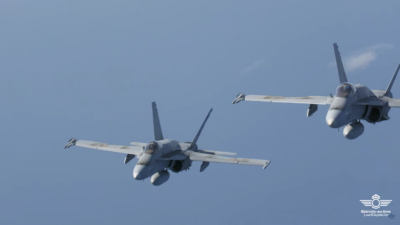Anyone passing through Gran Canaria airport this week may have noticed large numbers of fighter jets and other military aircraft taking off and landing at the Gando airbase next door, as part of the annual NATO DACT exercises which bring together a selection of top of the range fighters to test, train and evaluate pilots from across the NATO alliance. Ocean Sky-23, conducted by the Spanish Air and Space Force, invites international participation from some of the best of the best and has been in action all this week, where extensive advanced training is carried out, primarily focusing on air-to-air combat missions in the unique airspace of the Canary Islands. These missions emphasise the use of multiple resources simultaneously in hypothetical scenarios, aligning with the current geo-strategic reality.
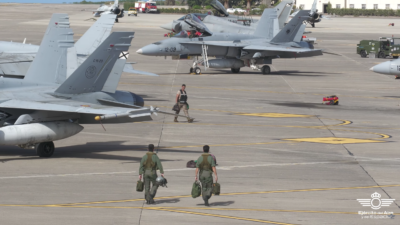 The overall responsibility for air defence of the Canary Islands, as well as the rest of Spanish territory, lies with NATO, utilising Spanish resources at their disposal. These sunny islands also mark the most southerly frontier in Europe, and as such play a special role in identifying and eliminating any potential threats that might emerge either from the skies over the Atlantic Ocean, or the entire West Coast of Africa. In order to exercise these resources, the Air Combat Command (MACOM) deploys combat aircraft units at Gando Air Base, on Gran Canaria, and auxiliary bases at the military airfield of Lanzarote.
The overall responsibility for air defence of the Canary Islands, as well as the rest of Spanish territory, lies with NATO, utilising Spanish resources at their disposal. These sunny islands also mark the most southerly frontier in Europe, and as such play a special role in identifying and eliminating any potential threats that might emerge either from the skies over the Atlantic Ocean, or the entire West Coast of Africa. In order to exercise these resources, the Air Combat Command (MACOM) deploys combat aircraft units at Gando Air Base, on Gran Canaria, and auxiliary bases at the military airfield of Lanzarote.
Auxiliary Support from Lanzarote
Interestingly Lanzarote acts not only as a resource for in-flight refuelling aircraft, which have also been co-ordinating interoperability between craft supplied from NATO-member air forces this week, but the easternmost canary island also serves other military platforms including as a forward operating base for US-supplied MQ-9 Reaper Drones, which fly out of 233 Squadron’s Talavera la Real air base in Badajoz, and have been recently deployed to and launched from Lanzarote, in the last year or so, flying various missions along the coasts of West Africa, and potentially could be used in the event of any perceived threat from within West Africa itself.
The 9th European Air Refuelling Training (EART 23) forms part of Ocean Sky, led by the European Air Transport Command (EATC), hosted by the Spanish Air Force at Lanzarote Air Base.
EART 23 runs in combination with the Spanish fighter exercises operating from Gando Air Base. Tanker aircraft, crews and mentors from France, Italy and Spain participate in the annually recurring drills.
EART 2023 underscores interoperability among global tanker and jet communities
“EART 23 focuses on dissimilar multi-tanker formation and tanker-to-tanker rendezvous procedures,” said the training director, French Air Force Lieutenant Colonel Arnaud Viltart, Head of EATC ‘s Training and Exercise Branch. “The 23 edition emphasises High Value Airborne Assets (HVAA) defence through threat reactions and retrograde procedures and underscores interoperability among global tanker and jet communities,” he added
Three NATO Allies participate: France with an Airbus A330 Multi-Role Tanker Transport (MRTT), Italy with a Boeing KC-767A and Spain with an Airbus A400M. The close link to the multinational live-fly fighter exercise Ocean Sky allows practicing common air-to-air refuelling tactics, techniques and procedures in a multinational environment.
While the tankers are stationed at Lanzarote Air Base, the base does not have any permanently based military aircraft. It is used by Air Force troops and an EVA 22 air defence radar which covers the Eastern Canary Islands and the maritime area up to the Sahara. The military aircraft covering Spain’s Canary Islands are stationed at Gando Air Base, Gran Canaria.
The aim of the exercise is to train and evaluate the Counter Air role together with allied air forces, increase interoperability and flying skills among the jet community.
 The objective of Ocean Sky is to train capabilities of the MACON structure in an air superiority campaign, enhancing the level of air-to-air combat readiness for fighter and attack units of the Spanish Air and Space Force. This includes Wings 11 and 14 equipped with Eurofighters, as well as Wings 12 and 14 equipped with EF-18Ms. Additionally, Wing 46, the host unit based in Gando, operate the veteran F/A-18A combat aircraft, which is soon to be updated.
The objective of Ocean Sky is to train capabilities of the MACON structure in an air superiority campaign, enhancing the level of air-to-air combat readiness for fighter and attack units of the Spanish Air and Space Force. This includes Wings 11 and 14 equipped with Eurofighters, as well as Wings 12 and 14 equipped with EF-18Ms. Additionally, Wing 46, the host unit based in Gando, operate the veteran F/A-18A combat aircraft, which is soon to be updated.
Foreign units also participated, including Lockheed Martin F-16C/D aircraft from the Greek Air Force, having previously taken part two years ago, and the Turkish Air Force flying the same model of combat aircraft. Additionally, air-to-air refuelling aircraft, crucial for combat operations, were deployed. These included the NATO Airbus Defence & Space A330 Multi Role Tanker-Transport (MRTT) and a Spanish A400M, deployed by Wing 31 from their base in Zaragoza, along with some Turkish Boeing KC-135s.
Four Phase Mission
 Ocean Sky-23 exercise is usually conducted in four phases, based on previous editions:
Ocean Sky-23 exercise is usually conducted in four phases, based on previous editions:
- The first phase involves the “Generation and Deployment of Forces” with the aim of executing all personnel and force preparation tasks, as well as the deployment of participating units.
- The theoretical phase includes a series of “force integration conferences” focused on familiarising participants with the aircraft involved in the exercise scenario, flight safety, combat tactics, etc., complementing flight training.
- The practical phase consists of dissimilar air combat training (DACT) missions in a wide variety of scenarios, involving a large number of combat aircraft to enhance interoperability between different participating units and to evaluate and improve tactics, techniques, and procedures used in such missions.
- The final phase focuses on “redeployment.”
Ocean Sky exercises have been conducted annually in the Canary Islands since 2004, though they were previously designated under the name DACT, Dissimilar Aircraft Combat Training, until 2017.
Training and Evaluation
 Ocean Sky 2023 is an extensive training and evaluation exercise, bringing together nearly a thousand military personnel from six European armies, all into the airspace of the Canary Islands, over the past few weeks. The objective of this exercise is to practice gaining air superiority in conflict situations.
Ocean Sky 2023 is an extensive training and evaluation exercise, bringing together nearly a thousand military personnel from six European armies, all into the airspace of the Canary Islands, over the past few weeks. The objective of this exercise is to practice gaining air superiority in conflict situations.
Colonel Rafael Hernández Maurín, head of the training and evaluation section of this exercise, stated that the aim is to prepare the air forces of the participating countries (Spain, Portugal, Greece, Turkey, Italy, and France) for potential wartime scenarios based on various preparation scenarios. The ultimate goal is to achieve air supremacy, providing cover for any ground operation that may be undertaken. This training operation is described as quite complex, resembling a sort of aerial choreography with the participation of numerous combat aircraft, with fighter jets being the most numerous.
 Ocean Sky training exercises are taking place in the restricted airspace known as Zone D97, just south of the Canary Islands, which is considered ideal for such exercises. According to the colonel, this military airspace, closed to private and commercial aircraft, south of the Canary Islands, spans 200 by 160 nautical miles, allowing for greater fluidity in operations. This offers advantages such as flying from near to the surface of the water to unlimited altitudes, providing much broader usage perspectives than in other European airspaces. Additionally, the meteorological conditions in this region offer opportunities for the utilisation of advanced technologies.
Ocean Sky training exercises are taking place in the restricted airspace known as Zone D97, just south of the Canary Islands, which is considered ideal for such exercises. According to the colonel, this military airspace, closed to private and commercial aircraft, south of the Canary Islands, spans 200 by 160 nautical miles, allowing for greater fluidity in operations. This offers advantages such as flying from near to the surface of the water to unlimited altitudes, providing much broader usage perspectives than in other European airspaces. Additionally, the meteorological conditions in this region offer opportunities for the utilisation of advanced technologies.
Ocean Sky 2023 commenced in mid-October and is expected to conclude at the end of this week, after 15 days of diverse exercises at the Gando Air Base. These exercises encompass combat scenarios, air traffic control, and search and rescue operations, among others.
 Describing the capabilities here as a “mini Air and Space Force,” Colonel Hernández highlighted that the Canary Islands are equipped with nearly all the systems available to the Ministry of Defence, due to their distance from the mainland.
Describing the capabilities here as a “mini Air and Space Force,” Colonel Hernández highlighted that the Canary Islands are equipped with nearly all the systems available to the Ministry of Defence, due to their distance from the mainland.
The fifty or so aircraft from participating countries are all currently based at Gando on Gran Canaria and on Lanzarote. They engage in missions lasting up to 14 hours, dedicating time to prepare, execute, and analyse each action.
Approximately 800 individuals are directly involved in the exercises, and foreign armies have been invited to foster cooperation between nations, reflecting the joint nature of most current military actions.
 Colonel Maurín emphasised that the pilot of the combat aircraft represents only the final step, with a large number of individuals working behind the scenes. They coordinate missions, monitor the condition of the aircraft, and orchestrate an operation that requires at least a month of preparation.
Colonel Maurín emphasised that the pilot of the combat aircraft represents only the final step, with a large number of individuals working behind the scenes. They coordinate missions, monitor the condition of the aircraft, and orchestrate an operation that requires at least a month of preparation.
Among the participants in the exercise are civilian air traffic controllers from Gran Canaria airport, who contribute to mission planning to ensure that regular operations at the airport are unaffected and that incidents are avoided.
All these efforts are coordinated by a European body, comprising the countries invited by the Spanish Air Force.
Ocean Sky 2023 commenced in mid-October and is expected to conclude at the end of this week. So there is still time to catch a glimpse of some of the most advanced military aircraft in the skies above Gran Canaria, if that is the sort of thing that interests you.

